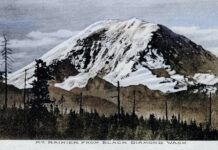In the days before television and radio, live music by local bands was an important component of cultural life. So it was in Newcastle when this circa 1914 photo of the Ford Mine Band was taken. The band members were employed in the Newcastle coal mines.
Several are identified in the third row: Charles Rouse (2nd from left), Ted Rouse (4th from left), and Tom Rouse (6th from left). To the rear behind the band members are Dr. George H.L. Sparling (left) and J.J. Jones (right). John J. Jones was one of the more prominent coal mining men of Washington in the early days.
He began his career at the Franklin No. 7 mine near Black Diamond in the 1890s, moving on to Issaquah and Newcastle. In 1922, while in the employment of Pacific Coast Coal Company, Jones was appointed to the position of Coal Inspector attending to the preparation and loading of coal. Dr. Sparling was the Newcastle company doctor in the 1890s before moving to Seattle in 1918. In 1937, Sparling became the King County Health Officer.
 Dr. Sparling was also instrumental in forming the Masonic lodge in Newcastle. When visitors to the lodge arrived by train, they would be greeted by the Ford Mine Band. The Ford Mine, which began operations in 1900, was named for J.C. Ford, President of Pacific Coast Coal. The band was uniformed and equipped by Mr. Ford. Located where Coal Creek crosses under the Newcastle – Lakemont Boulevard road, the Ford mine in time became the largest coal producer in King County.
Dr. Sparling was also instrumental in forming the Masonic lodge in Newcastle. When visitors to the lodge arrived by train, they would be greeted by the Ford Mine Band. The Ford Mine, which began operations in 1900, was named for J.C. Ford, President of Pacific Coast Coal. The band was uniformed and equipped by Mr. Ford. Located where Coal Creek crosses under the Newcastle – Lakemont Boulevard road, the Ford mine in time became the largest coal producer in King County.
This photo by Romans comes courtesy of JoAnne Matsumura, an Issaquah researcher. It also appeared in “The Coals of Newcastle” (1987) by Richard K. and Lucile McDonald






